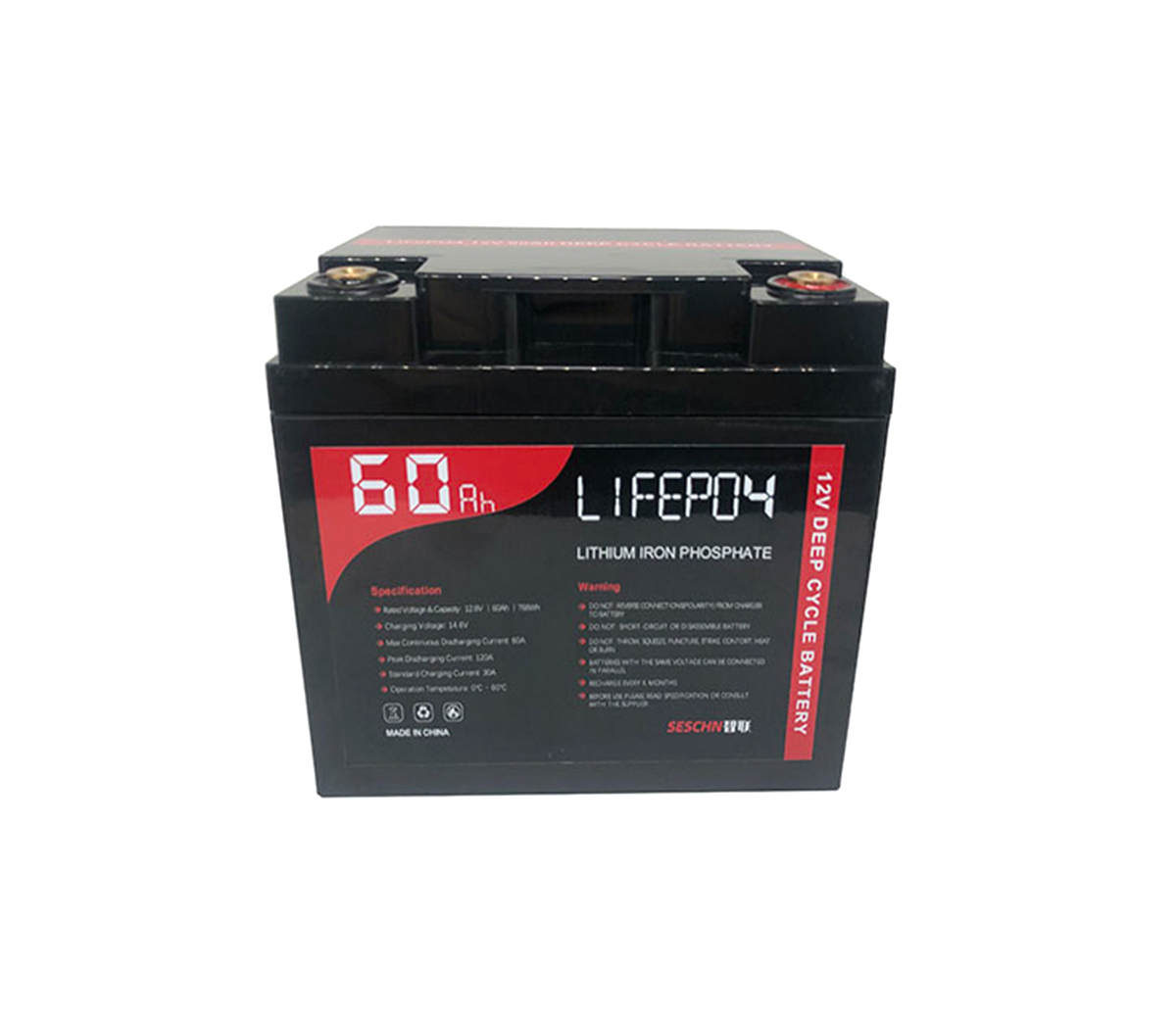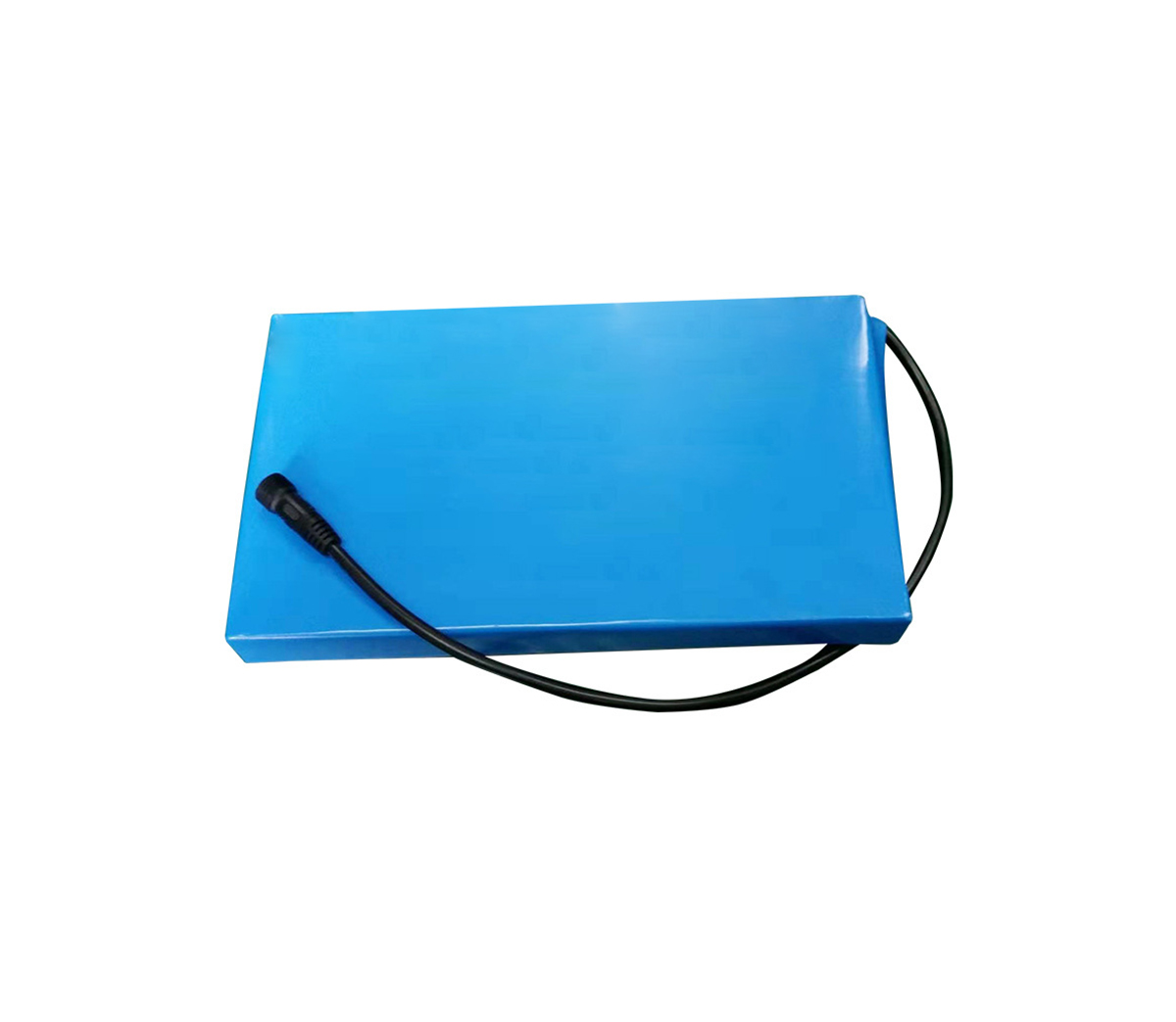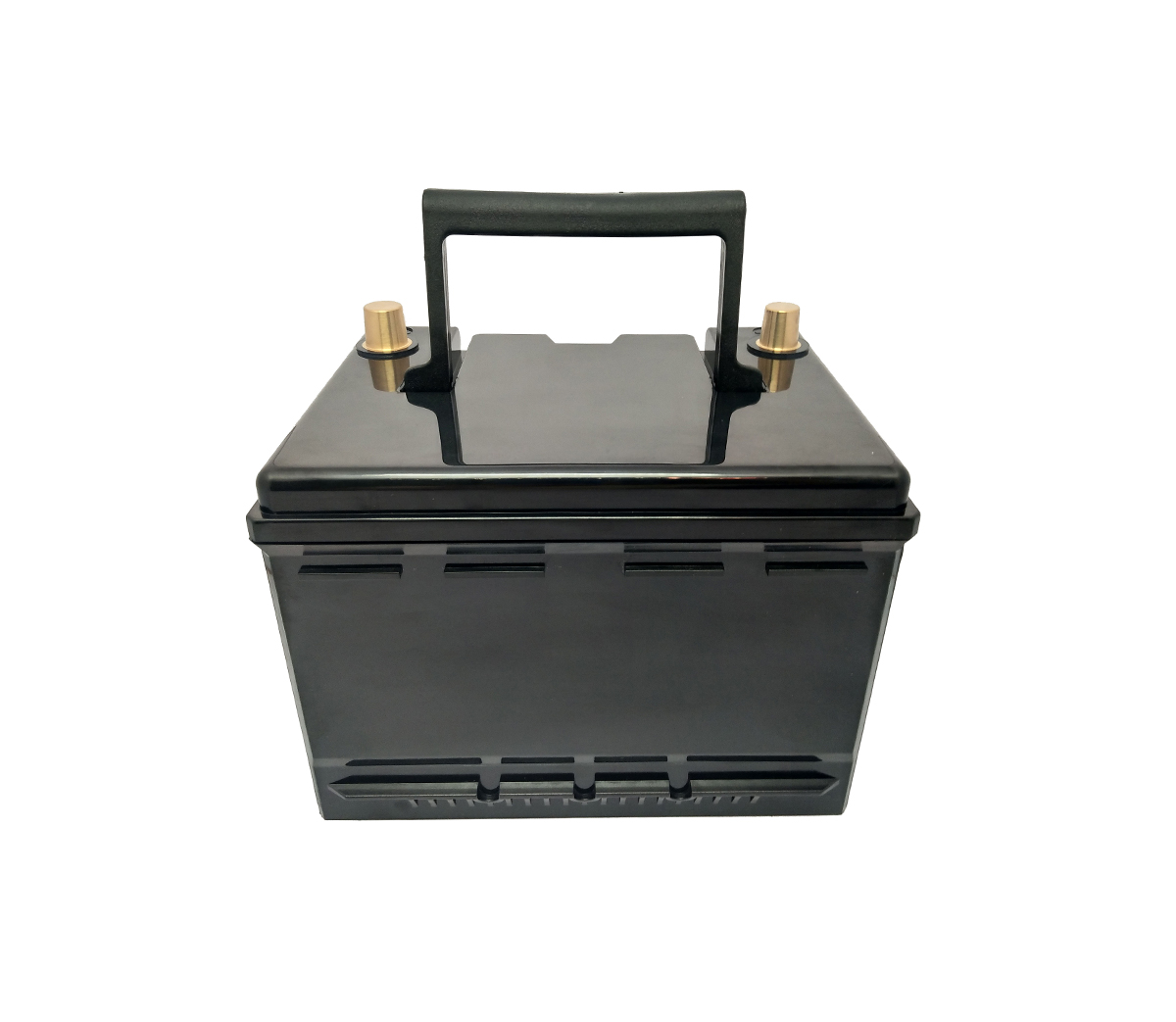The global climate is undergoing accelerated and irreversible changes, and we urgently need to complete the shift from fossil to renewable energy sources (mainly wind and solar).
As the proportion of these renewable energy sources increases in the grid, wind and sunlight are affected by the climate, making them intermittent and volatile, among other factors, so they can lead to a certain degree of imbalance between supply and demand in the grid, resulting in a shift in grid frequency, thus bringing a lot of pressure on frequency regulation.
Compared to traditional FM technology, Li-ion battery energy storage has an overwhelming advantage in response speed and has become the mainstream of domestic energy storage, especially grid energy storage applications. However, according to SES Power's observation, the two main challenges facing large-scale grid-level lithium battery energy storage are safety and recycling.
Li Ju's group at MIT and others have published a paper entitled "Key Challenges for Grid-Scale Lithium-Ion Battery Energy Storage" in Advanced Energy Materials. Yimeng Huang is the first author of this article.

A: "Type-A" Technology
The article begins by describing the need to focus on technologies that are more mature and can be implemented on a larger scale sooner ("Type-A" technologies), and suggests that a combination of wind/solar + lithium battery energy storage will be the best alternative to fossil energy in the next 20 to 30 years. In order to solve the problem of intermittent wind and solar energy supply, we need approximately 8 hours of power reserves.
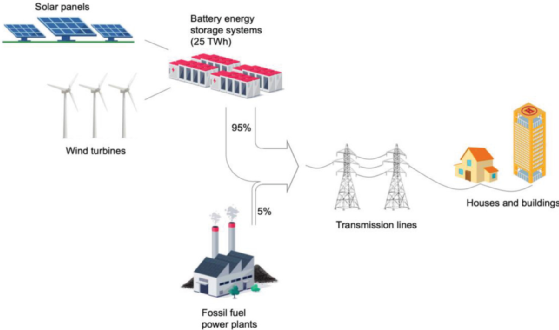
(Diagram of sustainable energy production with lithium-ion battery storage for 8 hours)
An 8 hour power reserve is approximately equal to 25 TWh of total lithium battery energy storage (US only) and this is approximately 100 times the size of current lithium battery energy storage. liFePO4//graphite (LFP) batteries with an energy density of 160 Wh/kg would require 156,250,000 tonnes of LFP batteries. This is about 500 kg of LFP cells per person (80 kWh of electrical storage), with about 6.5 kg of lithium atoms (which would need to be multiplied by 5.32 to get the corresponding lithium carbonate equivalent, LCE) and 29 kg of phosphorus atoms.
From this perspective, is there really enough lithium and other minerals on Earth to support it? The U.S. Geological Survey has determined that the global lithium atom "totals about 80 million tons" and that there is enough lithium for every person on the planet at 10.3 kg per capita.
"8 hours of energy" is a colloquial term used to indicate the scale of primary energy use, but when normalised by electrical energy use only, it is more like 60 hours or 2.5 days of electrical energy storage.
In addition to capital expenditure, what about operating expenses (OPEX), which are closely related to the cycle life of a LIB? The results show that the cycle life of a Li-ion battery has a very non-linear relationship with charge/discharge depth, temperature and charge rate. Therefore, better software and battery management systems are important for safe operation and maximising long-term economic value.
Hsu et al. and Lu et al. use deep neural networks to predict battery state of health (SOH), remaining useful life (RUL) and capacity-voltage curves, which are key to selecting newly manufactured or used batteries for home or grid-scale battery packs and dynamic load balancing.
B: Issues related to Li-ion energy storage safety
Safety is very important for large-scale lithium battery storage, as a failure or mishandling of one battery will trigger a series of chain reactions, such as the spread of fire, which can lead to very serious and uncontrollable consequences. The article gives examples of many cases where fires have occurred in lithium storage plants around the world, resulting in significant losses.
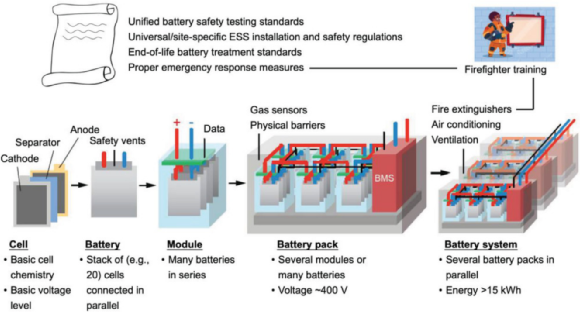
(Diagram of different levels of lithium-ion battery (LIB) storage and key components used for fire safety)
The probability of a single battery cell failing during its lifetime under normal use is approximately 10-7. Due to the cascading nature of fire incidents, the probability of an ESS facility triggering a fire in millions of cells at the same time, resulting in a serious accident, is clearly not low. These accidents result in power supply interruptions, severe pollution and significant economic losses. These liabilities need to be added to the operating costs and are often underestimated.
To date, most research on fire safety has focused on battery layers to improve battery materials. Although significant progress has been made in this area, the risk of thermal runaway within the battery cannot be completely eliminated. In addition to technological advances, the control of fire hazards depends on regulatory and management developments. lIBs must undergo a series of safety tests before they can be used in applications such as electric vehicles and stationary energy storage.
Although several standards and regulations have been issued internationally and nationally, there is still a lack of consistency in terms of test conditions, test parameters and pass/fail criteria for safety testing. This has led to significant fluctuations in LIB quality across the industry, which can make troubleshooting and safety policy development difficult.
Another issue is that most testing is conducted at the individual cell level, which may not be representative of safety performance at the pack/system level. There is still a lack of industry consensus on system design and system level safety assessment. Therefore, we must pay attention to the safety of large-scale Li-ion battery energy storage. In addition to research and breakthroughs in safety technology, further improvements are needed in various aspects such as fire protection, battery safety testing and grid energy storage codes.
C: The recycling of lithium batteries
The expanding scale of lithium battery energy storage in the coming decades will exacerbate and highlight the problems of resource shortage (e.g. lithium, cobalt, nickel and other resources) and environmental pollution (e-waste, manufacturing, etc.).
There is an urgent need to increase the proportion of lithium batteries recycled (the current recycling rate is still <10%) and to make a breakthrough in recycling methods. As of 2019, only 5% of lithium-ion batteries are recycled globally, and they are all intended to extract valuable metals, such as Co and Ni, in metallic form.
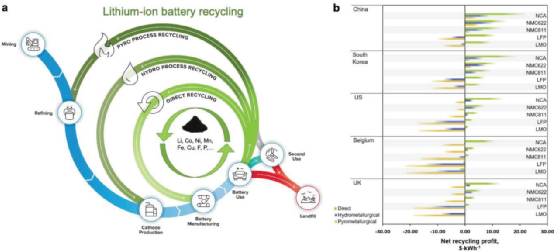
(Diagram of closed-loop recycling of lithium-ion batteries. b) Net profit from battery recycling)
Alongside advances in recycling technology, waste management and policy development should be developed to ensure a truly circular economy. As game-changing recycling technologies cannot mature in a short period of time, it is likely that in the near future most LIBs will remain unrecovered and end up in storage, landfill or incineration.
If not managed and disposed of properly, the toxic organic solvents, plastics and heavy metals in waste LIB can leach into the soil and pollute the oceans. There are several existing standards and regulations for LIB disposal at the federal and state levels, such as the Resource Conservation and Recovery Act in the US and the Hazardous Waste Disposal Regulations in China, but there are still issues such as unclear classification of LIBs, failure to keep up with technological advances, and lack of data collection standards, reporting and tracking, which should be addressed in a timely manner.
D: Outlook
At the current stage of technology, considering economic and environmental factors, 8 hours of Li-ion battery storage combined with wind/solar energy (Type A technology), producing energy to meet 95% of demand and using conventional fossil fuels as a back-up power source, should be a realistic strategy for future energy decarbonisation until Type B technologies (such as fusion power engineering and superconducting transport) mature.
In terms of technology, there is a better understanding of the origins of fire safety generating heat and thermal runaway. In terms of recycling, an optimal combination of shallow and deep recycling can further enhance the economic and environmental benefits of recycling, creating a closed loop of valuable elements such as Co, Ni and Li within the renewable energy industry and significantly reducing the resource and extraction burden.
In addition, regulations and management must improve in tandem with technological advances to further enhance safety and sustainability. Up-to-date site-specific installation/safety guidelines and contingency measures need to be developed, the fire risk of end-of-life LIBs needs to be taken seriously, and waste management policies need to be developed and implemented.
Achieving a circular economy combining renewable energy with LIB storage will require extensive collaboration between academia, industry and government.
With improvements in technology and management, we will hopefully achieve battery packs costing <$90/kWh that can be stably cycled 20,000 times and beyond, enabling safe and sustainable grid storage.
[Literature Details] Yimeng Huang, Ju Li, Key Challenges for Grid-Scale Lithium-Ion Battery Energy Storage, Advanced Energy Materials 2022, 2202197. https://doi. org/10.1002/aenm.202202197

Author] Prof. Ju Li

As a manufacturer with nearly two decades of experience in the lithium battery industry, SES Power has been focusing on the product needs of lithium battery energy storage systems for a long time, for which we have introduced corresponding products for different application scenarios to achieve the best cost performance, such as lead-acid replacement products with balanced performance of square aluminum-cased lithium iron phosphate batteries (12V100Ah, 12V200Ah, 24V100Ah, etc.), and large lithium-ion battery storage systems. 24V100Ah, etc.), high-current (2000A) starter lithium batteries, UPS high-voltage lithium battery systems (up to 860V), 3Kw~20Kw off-grid, grid-connected, islanded lithium battery storage systems, wall-mounted home energy storage systems 48V100Ah, 48V200Ah, stacked energy storage systems (single 51.2V100Ah, supporting up to 15 stacks), etc.
If you have any questions about lithium batteries, you are welcome to contact us.















